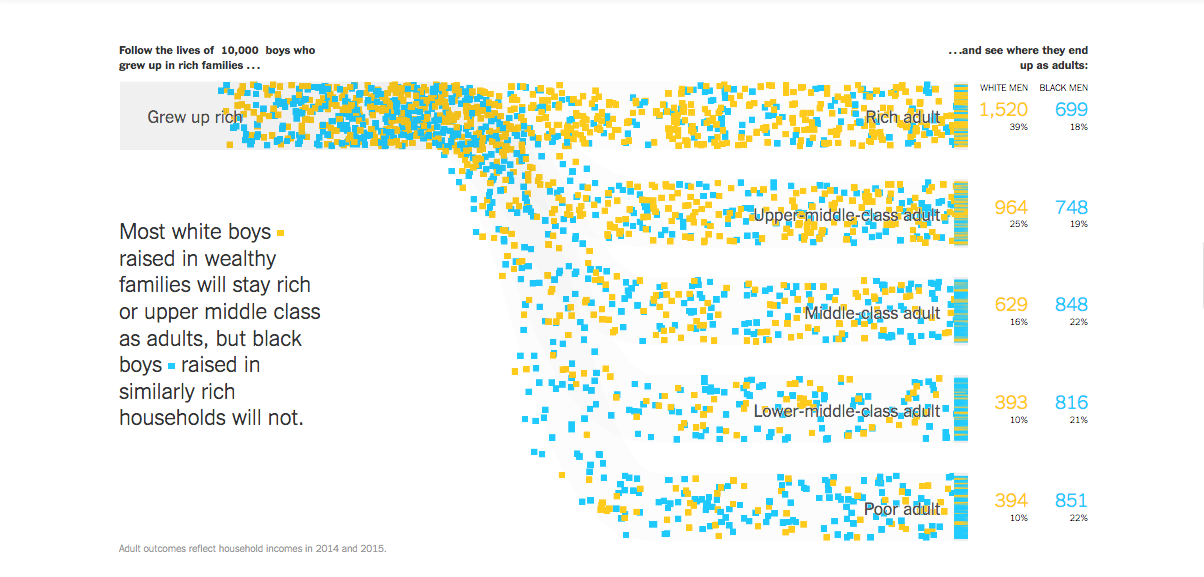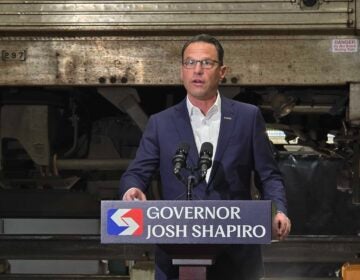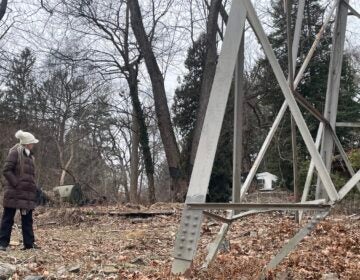Growing up rich in a wealthy area doesn’t solve the racial income gap for black boys

No matter how wealthy their upbringing, black boys raised in America are more likely to end up poor in adulthood than white peers, according to an explosive new study conducted by researchers at Stanford, Harvard and the Census Bureau, the New York Times reports. Researchers analyzed de-identified census data on 20 million children and their parents over decades to find that a deep racial income gap persists. “Even when children grow up next to each other with parents who earn similar incomes, black boys fare worse than white boys in 99 percent of America. And the gaps only worsen in the kind of neighborhoods that promise low poverty and good schools,” the NYT reports. The study “undermines the widely held belief that class, not race, is the most fundamental predictor of economic outcomes for children in the U.S,” says NPR in a story about the study.
The findings resonate in Philadelphia, where 44.2 percent of the population is African American and 17.7 percent of African Americans are unemployed, according to Philadelphia Works. That’s compared to unemployment rates for African Americans at 9.6 percent nationally and 10.5 percent in Pennsylvania, according to the Bureau of Labor Statistics. The national average unemployment rate is 5.3 percent in the United States and 7 percent in Philadelphia. The study highlights Silver Spring, Maryland as one of “the rare neighborhoods where black and white boys appear to do equally well;” noting that these neighborhoods “mostly had low poverty rates…[and] were the places where many lower-income black children had fathers at home.”
The study revealed a profound gender disparity within black families.”Though black girls and women face deep inequality on many measures, black and white girls from families with comparable earnings attain similar individual incomes as adults,” writes the NYT. The reasons for that are manifold, researchers say.While black women also face racism and sexism, black men often experience individual and structural racism differently: “As early as preschool, they are more likely to be disciplined in school. They are pulled over or detained and searched by police officers more often.” In the home, one “pathbreaking finding” of the study, according to Harvard sociologist William Julius Wilson is the “the presence of fathers in a given census tract” on the economic outcomes for black boys. Census data found that 63 percent of white children living in low-poverty neighborhoods had fathers present, while only 4 percent of black children do. In high-poverty neighborhoods, 1 percent of white children had only a few fathers present while 66 percent of black children did. So in the greater community, the presence of fathers in a neighborhood is crucial, especially for black children: researchers say that the presence of mentors, even “mentors who aren’t children’s parents, but who share those children’s gender and race,…may indicate other neighborhood factors that benefit families, like lower incarceration rates and better job opportunities.”
The study also looked at for Hispanic, white, Asian, and Native Americans, finding that over generations, Native Americans have the second-lowest rates of upward mobility after African-Americans and Latinos and Asian-Americans are experiencing upward mobility opportunities given a few caveats. The study found that the gap between Latinos and whites narrows if mobility stays the same over multiple generations and Asian-Americans have about the same mobility levels as whites, though “that advantage largely disappears when the researchers look only at children whose parents were born in the United States.”
A college degree is no guarantee for people of color
In Philadelphia, for people of color to close the gaps in income and wealth, we need to focus on careers — not just jobs writes EducationWorks president and CEO Miles Wilson in an op-ed for the Philadelphia Inquirer. Wilson applauds Mayor Kenney’s new workforce strategy, but challenges us to “expand the mayor’s strategy by building sustainable career paths for people of color.” Wilson cites recent studies that show that building an education pipeline is not enough to pull people out of poverty: a Brookings Institution study reports that there “has been a significant increase in the rate of four-year college completion among black Americans, especially women. … But even when they do, they are less able to create greater economic security” and a Center for Economic and Policy Research report concluded “that black college graduates of all ages consistently have higher unemployment rates, higher underemployment rates, and lower wages than their white counterparts, even when black students complete STEM majors, reinforces concerns that racial discrimination remains an important factor in contemporary labor markets.”
Wilson points to a few direct actions, starting with getting the region’s business community to recognize “the ‘disconnect’ between getting a diploma and launching a productive career” to ‘activate’ on the issue. He encourages employers to broaden the traditional recruitment network to include historically black colleges and universities as well as the Community College of Philadelphia. However, getting the job is not enough, though. Wilson emphasizes then the importance of ongoing support through mentorship, training, and creating a welcoming and supportive environment that gives new hires a realistic opportunity to succeed.
PSA: Pedestrian street activity season!
Even though Winter’s storms keep sucker punching our meteorologists’ confidence and making our streets go to pot, Spring is around the corner, and we have tours that celebrate Philadelphia’s built, breathing, and porous environment to look forward to.
Streets Dept is back with its 2nd Saturday Street Art Tours, where we explore monthly the street art, graffiti, murals in Philadelphia’s public spaces. This month, Conrad Benner takes us to Kensington, in particular, 5th and Cecil B. Moore, “one of the most active and accessible graffiti spots in the city that’s not in an abandoned building or along a train corridor.”
The Preservation Alliance for Greater Philadelphia kicks off their architectural walking tour season with a goldie but a goodie, spring edition: a co-presented tour with the Philadelphia History Museum on the Golden Age of Retail that takes us through the architectural history of Philadelphia’s central commercial district and recounts “the tricks of the trade that the city’s visionary merchants once used to generate goodwill and foot traffic during the springtime shopping season.”
Hey, what about your neighborhood? How does the built environment affect your community? How do you navigate your daily life where you call home? Take us on a walk and show us! Sign up for Jane’s Walk 2018 and take us on a walk through your world the first weekend of May.
WHYY is your source for fact-based, in-depth journalism and information. As a nonprofit organization, we rely on financial support from readers like you. Please give today.







